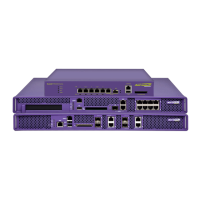Diagnostics
Summit WM3000 Series Controller System Reference Guide472
Enabling this checkbox allows you to select the file location where you wish to store the log
message.
4 Select the Use SNMP V2 only checkbox to use SNMP v2 to debug the applet.
Check whether you have access to SNMP v2 by clicking on the Test SNMP V2 access button. If SNMP
v2 access is available, the test icon will change from grey to green, indicating the SNMPv2 interface
is viable on the controller.
5 Select the severity of the message you wish to store in the log file.
The Message Severity section allows you to report a bug and log it as per the following severity
levels:
● Fatal - loss of data or controller functionality
● Error - controller data compilation problem, could result in data loss
● Warning - potential data loss of configuration corruption
● Informational - data that may be useful in assessing a potential error
● Debug - information relevant to troubleshooting
● None - no impact.
6 Select the message deployed when a bug is raised.
The What Kind of message should be seen field allows you to select a range of parameters for returned
messages while debugging. Move your mouse pointer over a message checkbox for a message
description.
a Click the Advanced button to display the entire list of message categories when bugs are raised.
Select the checkboxes corresponding to the message types you would like to receive.
Each message category is enabled by default. Click the Simple button to minimize this area and
hide the available message categories.
b Click the All Messages button to select all the message categories.
c Click the No Messages button if you do not want to select any of the message categories.
7 Click the Apply button to save the changes you have applied within this screen.
8 Click the Revert button to revert back to the last saved configuration.
Configuring a Ping
The controller can verify its link with other controllers and associated MUs by sending ping packets to
the associated device. Use a ping to test the connection between the controller and IP destinations you
specify. For each ping packet transmitted, statistics are gathered for the round-trip time (RTT) between
the controller and its destination. The RTT is the time (in milliseconds) for a ping packet to travel from
the controller to its target destination and back again. This number can vary significantly due to the
random nature of packet routings and random loads on the controller and its destination.
To view the controller’s existing ping configuration:

